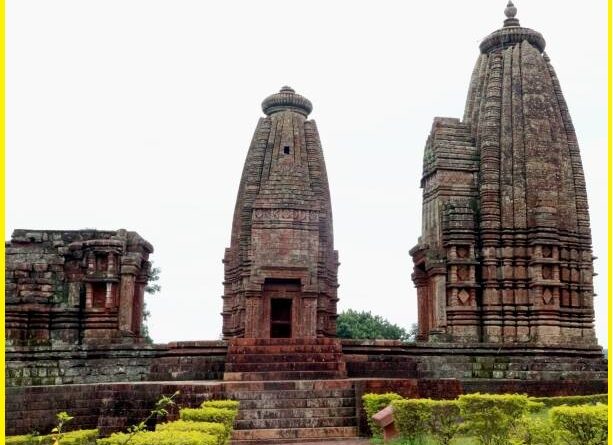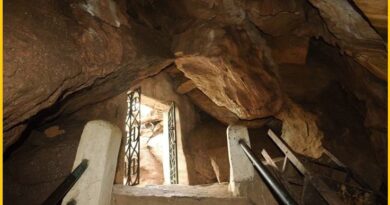Amarkantak-The Holy Abode of Rivers and Sacred Landscapes
Amarkantak
Amarkantak is a town located in the Anuppur district of Madhya Pradesh, India. It is known as a holy place for Hindus, as it is believed to be the source of the rivers Narmada and Son. The town is surrounded by dense forests and hills, making it a popular destination for nature lovers and pilgrims. Amarkantak is also home to several temples and religious sites, including the Narmada Udgam Temple and the Kapildhara Waterfall.
Amarkantak Plateau Geography
The Amarkantak plateau is a geographical feature located in central India, situated at an elevation of around 1,048 meters, and is known for its lush green forests, hills, and the convergence of several rivers.
The plateau is considered to be a sacred place in Hindu mythology, as it is believed to be the source of the rivers Narmada, Son, and Johila. These rivers flow in different directions, with the Narmada flowing towards the west, Son towards the north, and Johila towards the east.
The Narmada rises in the western flank of the Amarkantak Plateau and is a west-flowing river. The Son rises near Pendra, just east of the headwater of the Narmada River, and is a north-northwest flowing river. Son’s tributary Johilla River, also rises in Amarkantak.
The Amarkantak plateau is also renowned for its biodiversity, with a wide variety of flora and fauna. It is home to several species of plants, animals, and birds, making it a popular destination for nature enthusiasts and wildlife lovers. The plateau is not only significant from a natural and religious standpoint but also offers picturesque landscapes and stunning viewpoints, attracting tourists and pilgrims alike.
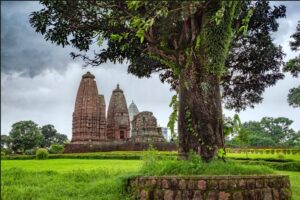
Amarkantak Tourism
The Amarkantak Hills are known for their scenic beauty, dense forests, and diverse wildlife. The hills are covered with lush greenery and are home to a wide variety of flora and fauna, including medicinal plants and rare species of animals and birds.
The hills are considered sacred by Hindus, as they are believed to be the abode of several deities. The Narmada Udgam Temple, situated atop the Amarkantak Hills, marks the origin of the holy river Narmada, making it an important pilgrimage site.
Tourists and nature enthusiasts visit the Amarkantak Hills to enjoy the serene surroundings, embark on trekking trails, and explore the natural beauty of the region. The hills offer breathtaking views, especially during sunrise and sunset, making it a popular destination for photography and sightseeing. Some of the best places in Amarkantak to see are-
Amarkantak Temple
Amarkantak is a well-known Hindu pilgrimage destination that is popularly known as “Teerthraj” – “the king of pilgrimages”. It is the meeting point of the Vindhya and the Satpura Ranges, with the Maikal Hills being the prominent one among them.
The Amarkantak Temple is a prominent Hindu temple. It is dedicated to Lord Shiva and is considered a highly sacred site for Hindu devotees. The temple is situated at the confluence of the rivers Narmada and Sone, which are believed to have originated from the Amarkantak plateau.
The Amarkantak Temple features traditional Hindu architecture and is adorned with intricate carvings and sculptures. The main deity worshipped in the temple is Lord Shiva, who is revered as the presiding deity of Amarkantak.
Devotees visit the Amarkantak Temple to seek blessings, perform religious rituals, and offer prayers to Lord Shiva. It is believed that visiting the temple and taking a holy dip in the rivers at this sacred site can wash away sins and bring spiritual purification.
Apart from the main Amarkantak Temple dedicated to Lord Shiva, there are several other temples in the vicinity, including the Narmada Udgam Temple, which marks the origin of the river Narmada. These temples collectively make Amarkantak a significant pilgrimage destination for Hindus.
Also, read- Mainpat in Surguja- A Tranquil Town and ‘Switzerland of Chhattisgarh’
Narmada Udgam
Three rivers – the holy Narmada, the Sone, and the Johila emerge from the Amarkantak hill. A rising stream of Narmada can be seen at The Narmada Udgam Temple, the most visited place in Amarkantak. Every year on the occasion of Narmada Jayanti, devotees in abundance gather here to attend the special event. Narmada Udgam Temple is surrounded by incredible natural wonders like Narmada Kund, Sonemuda (the source of river Sone), plunging Dugdhara Waterfalls, and the Kapildhara waterfalls.
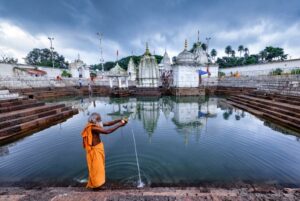
Shri Yantra Mandir
The most noticeable feature of the Shri Yantra Mandir is the massive sculpture with four heads at the entrance path. The head represents the face of goddesses Laxmi, Saraswati, Kali, and Bhuvaneshwari. They are accompanied by statues of Lord Ganesha and Kartik, as well as 64 exquisitely carved deities also known as Chaunsath Yoginis. The temple is constructed as a 3D projection of the Sri Yantra or Sri Chakra, which forms the core of the Sri Vidya worship in Hinduism.
Mai Ki Bagiya
The natural tree grove known as Mai ki Bagiya surrounds the woodland and is devoted to the Goddess Narmada. The garden has Gulbakavli, Roses, and other blooming plants in addition to mango, banana, and other fruit trees. The garden also houses a Charanodak Kund pond and a small temple dedicated to the Goddess Narmada. This location is thought to be where the Narmada River actually originated.
Apart from natural spots, Amarkantak is home to many temples. The group of ancient temples of the Kalachuri period such as Machhendranath, Pataleshwar and Kailash Narayan, Shri Yantra Mandir, Mrityunjay Ashram, Bhrigu Kamandal are some more places to see in Amarkantak that you should not miss exploring. At a short distance from Amarkantak is the Kabir Chabutra, where the mystic poet Sant Kabir is said to have meditated and achieved salvation.
Waterfalls of Amarkantak
Kapil Dhara
Kapil Dhara is associated with the legends of Saint Kapil or Kapila. It is said that he spent 12 years in meditation at this place. The holy Narmada pours downhill as a gigantic waterfall forms the Kapil Dhara waterfall. On the rocky banks of the brisk, the blue water is the holy Narmada and is a popular picnic spot for visitors.
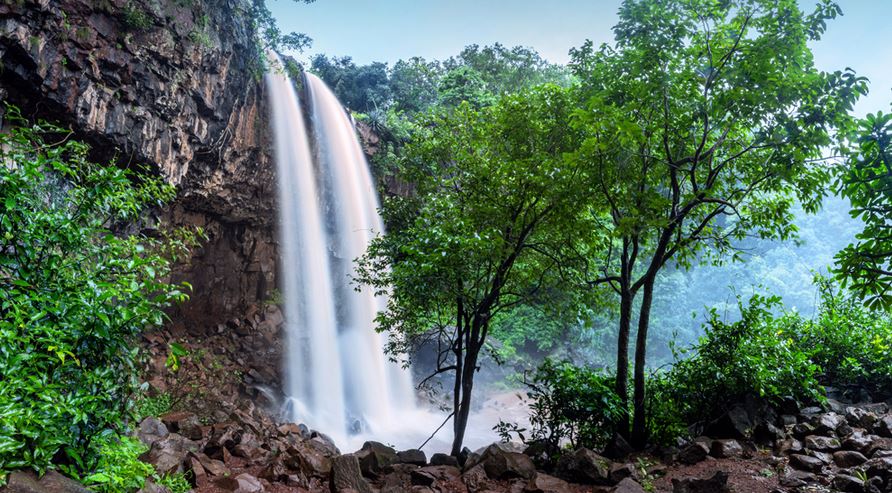
Dugdh Dhara
Visitors can take a 1-kilometer trek from the Kapil Dhara to the next Narmada Waterfall which is Dugdh Dhara. This trek is quite a popular thing to do in Amarkantak among tourists. It is surrounded by rocky steps with wild bushes. The froth of water looks like a stream of Dugdh (Milk), naming it the Dugdh Dhara waterfall.
Things to do in Amarkantak
There are several activities and things to do in Amarkantak that cater to different interests. Some of the popular ones-
Take a Dip in the Holy Rivers-Visit the confluence of the Narmada and Sone rivers and take a dip in their sacred waters. It is believed to be spiritually purifying.
Enjoy Waterfalls- Visit the stunning Kapildhara and Durgdhara waterfalls and marvel at their natural beauty. Take a refreshing shower under the cascading water and enjoy the scenic surroundings.
Trekking and Nature Walks- Explore the lush green forests and hills of Amarkantak through trekking trails and nature walks. Enjoy the serene ambiance and spot diverse flora and fauna along the way.
Wildlife and Bird Watching- Visit the nearby Achanakmar Wildlife Sanctuary and Amarkantak Biosphere Reserve to witness the rich biodiversity. Spot wildlife species and indulge in birdwatching.
Visit Sonemuda and Kabir Chabutara- Explore Sonemuda, the birthplace of the Son River, and Kabir Chabutara, a memorial dedicated to the famous saint-poet Kabir.
Attend Festivals– Experience the vibrant atmosphere of festivals celebrated in Amarkantak, such as Narmada Jayanti and Kartik Purnima. Witness the traditional rituals, cultural performances, and processions.
Visit Ashrams and Spiritual Retreats- Engage in yoga, meditation, and spiritual practices at the ashrams and retreat centers in Amarkantak. Seek inner peace and tranquility
Enjoy Local Cuisine- Indulge in local cuisine and savor traditional dishes of Madhya Pradesh, such as dal baffle, poha, jalebi, and more, at local eateries.
MPT holiday homes Amarkantak
MPT (Madhya Pradesh Tourism) Holiday Homes in Amarkantak are government-run accommodations that provide comfortable and affordable stay options for tourists visiting the region. These holiday homes are operated by the Madhya Pradesh State Tourism Development Corporation.
The MPT Holiday Homes in Amarkantak offer a range of rooms and cottages to suit different traveler preferences and budgets. These accommodations are typically located in scenic surroundings, providing a peaceful and serene environment for guests.
The facilities and amenities provided at MPT Holiday Homes may include well-furnished rooms, attached bathrooms, hot water supply, room service, and in-house dining options. Some holiday homes may also have additional facilities like gardens, play areas, and parking facilities.
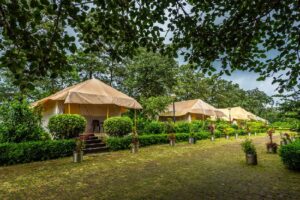
To book a stay at MPT Holiday Homes in Amarkantak, visit the official website of Madhya Pradesh State Tourism Development Corporation or contact their offices. It is advisable to make reservations in advance, especially during peak tourist seasons, to secure your preferred accommodation.
Best time to visit Amarkantak
Although The Place can be toured throughout the year, avoid the peak summer season. The best time to visit Amarkantak is between September to February. Post-monsoon brings greenery to the environment, making it picturesque to visit. Narmada Jayanti, Makar Sankranti, and Shiv Chaturdashi are celebrated during winter with great enthusiasm.
How To Reach Amarkantak
The nearest airports to Amarkantak are Jabalpur at 228 km and Raipur at 230 km. Both airports are well-linked to many major cities in India. The closest railhead to Amarkantak is situated at Pendra Road in Chattishgarh at 42 km. Amarkantak is 71 km from Anuppur, the district headquarter. There is the option of direct buses from Rewa, Allahabad, Mandla, Seoni, Bilaspur, Katni, Jabalpur, and Raipur.
Pendra road to Amarkantak
The distance from Pendra Road to Amarkantak is approximately 45 kilometers. The most convenient way to reach the place from Pendra Road is by road. You can hire a taxi or take a private vehicle. The journey takes around 1.5 to 2 hours, depending on the traffic and road conditions. Madhya Pradesh State Transport buses also operate from Pendra Road to Amarkantak. You can check the bus schedules and timings at the Pendra Road bus stand.
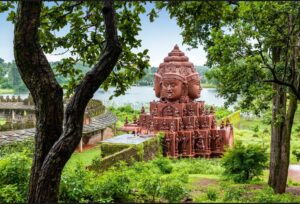
Madhya Pradesh State Road Transport Corporation (MPSRTC) operates regular bus services between Bilaspur and Amarkantak. You can check the bus schedules and timings at the Bilaspur bus stand or the official website of MPSRTC. The journey duration is usually around 4 to 5 hours, depending on the route and traffic conditions.
There are also private bus operators that run buses between Bilaspur and Amarkantak. These buses may offer different amenities and ticket prices. You can inquire about the availability of private buses at the Bilaspur bus stand or check online for private bus operators servicing this route.
